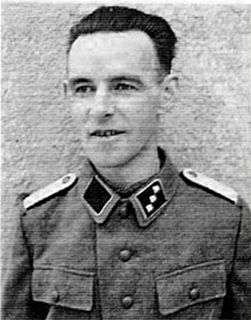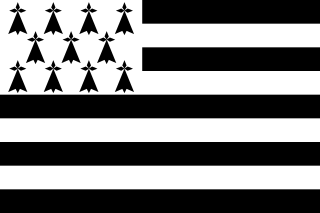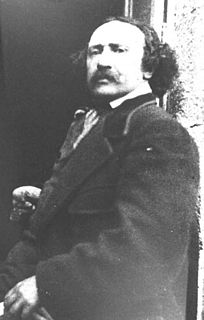
Célestin Lainé (1908–1983) was a Breton nationalist and collaborator during the Second World War who led the SS affiliated Bezen Perrot militia. His Breton language name is Neven Hénaff. He was a chemical engineer by training. After the war he lived in Ireland.
Bleun-Brug is a Catholic association oriented towards Breton nationalism.

Breton nationalism is a form of regional nationalism associated with the region of Brittany in France. The political aspirations of Breton nationalists include the desire to obtain the right to self-rule, whether within France or independently of it, and to acquire more power in the European Union, United Nations and other international institutions.

Breiz Atao, was a Breton nationalist journal in the mid-twentieth century. It was written in French, and has always been considered as a French nationalist journal by the non-francized Bretons. The term is also used for the broader movement associated with the journal's political position.
The abbé Jean-Marie Perrot, in Breton Yann Vari Perrot, was a Breton priest, Breton independentist assassinated by the Communist resistance. He was the founder of the Breton Catholic movement Bleun-Brug.
Olier Mordrel is the Breton language version of Olivier Mordrelle, a Breton nationalist and wartime collaborator with the Third Reich who founded the separatist Breton National Party. Before the war, he worked as an architect. His architectural work was influenced by Art Deco and the International style of Le Corbusier. He was also an essayist, short story writer, and translator. Mordrel wrote some of his works under the pen names Jean de La Bénelais, J. La B, Er Gédour, A. Calvez, Otto Mohr, Brython, and Olivier Launay.

Before and during World War II, the various Breton nationalist movements were generally right-wing, and sometimes fascist. The extent to which this led to collaboration with the Nazi occupiers of France during the war, together with their motivations, is a matter of historical controversy.

François-Marie Luzel, often known by his Breton name Fañch an Uhel, was a French folklorist and Breton-language poet.

François Debeauvais was a Breton nationalist and wartime collaborator with Nazi Germany. His name is also spelled in many "Breton" variants: François Debauvais, Fransez Debeauvais, Fransez Debauvais, Fañch Debeauvais, Fañch Debauvais, Fañch deb.

Morvan Marchal, is the Breton name of Maurice Marchal, an architect and a militant Breton nationalist. He is best known for having designed the national flag of Brittany.
Jeanne Coroller-Danio was a Breton nationalist and writer. She is also known as Jeanne Coroller and Jeanne Chassin du Guerny. Her best-known pen-name was Danio, but she published her work under various pseudonyms: J.C. Danio, Jeanne de Coatgourc'han, Gilles Gautrel and Gilesse Penguilly.
The Breton Federalist League was a short-lived Breton political party in the 1930s. A new organization with the same name was created in the 21st century.
The Breton Autonomist Party was a political party which existed in Brittany from 1927 to 1931.
James Bouillé was a French architect based in Brittany.
Breiz da Zont, was a Breton nationalist periodical active during the 1930s. It was affiliated to an extremist offshoot of the Breton Autonomist Party.
The Breton Nationalist Party was a French political party that advocated independence for Brittany. It existed from 1911 to 1914.

François Eliès, born Fañch Eliès and better known by the pseudonym Abeozen, was a Breton nationalist, novelist and dramatist who wrote in the Breton language. Abeozen was also a noted scholar of the Welsh language.
Gabriel-Jean-Maie Milin or Gab Milin was a poet, folklorist and philologist writing in the Breton language, sometimes under his bardic name, Laouenan Breiz. He was also a naval clerk and mayor of the Île de Batz.







